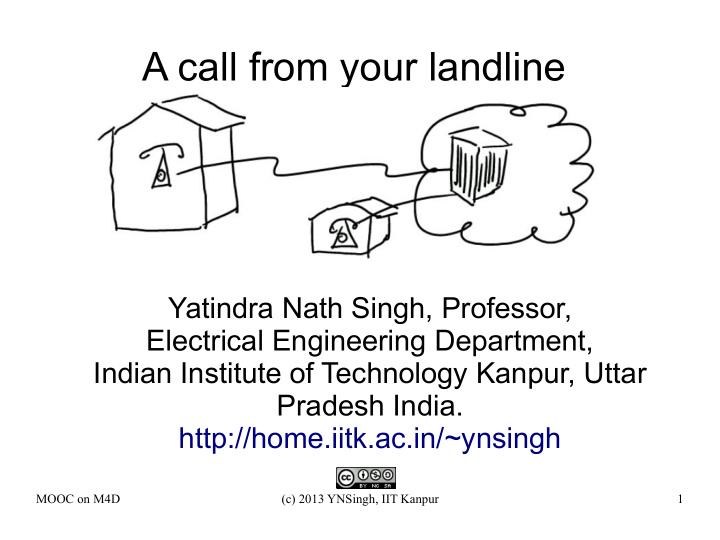



A call from your landline Yatindra Nath Singh, Professor, Electrical Engineering Department, Indian Institute of Technology Kanpur, Uttar Pradesh India. http://home.iitk.ac.in/~ynsingh MOOC on M4D (c) 2013 YNSingh, IIT Kanpur 1
Telephone Instrument ● Electronic instrument – patent granted in 1876 to Alexander Graham Bell. ● Mechanism to sense voice, transfer it over pair of wires and reproducing it a other end. ● 48V DC supply from the exchange – gives power to equipment. ● Independent of home supply. Image source: wikipedia.org MOOC on M4D (c) 2013 YNSingh, IIT Kanpur 2
● Telephone – ringer unit – to indicate incoming call. ● Telephone need to be connected to telephone exchange (switch) – a telephone wire from your home to operator MOOC on M4D (c) 2013 YNSingh, IIT Kanpur 3
Steps involved in a call ● You lift the handset – It has microphone and earphone, and you hold it with your hands. ● The wire from your phone connected to a electronic circuit in exchange (line interface card or line- card) Image source: wikipedia.org MOOC on M4D (c) 2013 YNSingh, IIT Kanpur 4
● Line card detects – handset lifted from cradle. ● Applies dial tone – you cannot dial a number before you get a dial tone. – Indicates that line card ready to recieve digits from you. ● Dial digits – Pulses, cards counts the pulses and find the dialled digits. – DTMF (dual tone multi frequency), push button – sends two tones. ● Card find the pushed digit based on combination of tones received. ● On receiving digits – line cards applies hunting tone to phone, indicating call setup in progress – The numbers are passed to exchange processor. MOOC on M4D (c) 2013 YNSingh, IIT Kanpur 5
● Exchange processor – From the port id (where wire from home is attached), knows who you are? – It analyses if the call you want is permitted or not (based on your subscription) – It than looks at routing tables for how the call can be routed to destination. ● Complete route is decided ● Only the next exchange (switch) is decided. Next switch responsible for further onward routing. MOOC on M4D (c) 2013 YNSingh, IIT Kanpur 6
● Each exchange runs software (intelligent entity) on its processor. ● Intelligent entities in all the exchanges (switches) can interact with each other – same way as PCs can interact over internet. ● A network is formed for message transfer between these entities – SS7 network. ● SS7 (signaling system no.7) MOOC on M4D (c) 2013 YNSingh, IIT Kanpur 7
● Exchange processor send messages to all the intermediate exchanges, asking for resources (reservation of bandwidth for your call) ● Also ask the last exchange if the user is busy. ● All exchanges, blocks the resources – bandwidth MOOC on M4D (c) 2013 YNSingh, IIT Kanpur 8
● Destination exchange confirm if the user is free. ● Source exchange ask everyone to setup the path. ● Asks destination exchange to apply ringing current to destination phone. ● Hunting tone is stopped. ● Destination current send ringing tone back to source phone. MOOC on M4D (c) 2013 YNSingh, IIT Kanpur 9
● Once the person at other end, lifts the handset ● Destination exchange stops the ringing current and ringing tone both and path is finally made through. ● Destination exchange also sends message to source that call is through. ● Source exchange records the details – Call detail record (CDR) – Used for generating bill MOOC on M4D (c) 2013 YNSingh, IIT Kanpur 10
● For a call two paths are used – One in each direction – Inefficienct, as information – not transferred in both the direction all the time. ● DTMF – the tones in voice band are used. – Once a call is through – DTMF can be used to signal the equipment at the other end of the path MOOC on M4D (c) 2013 YNSingh, IIT Kanpur 11
Recommend
More recommend